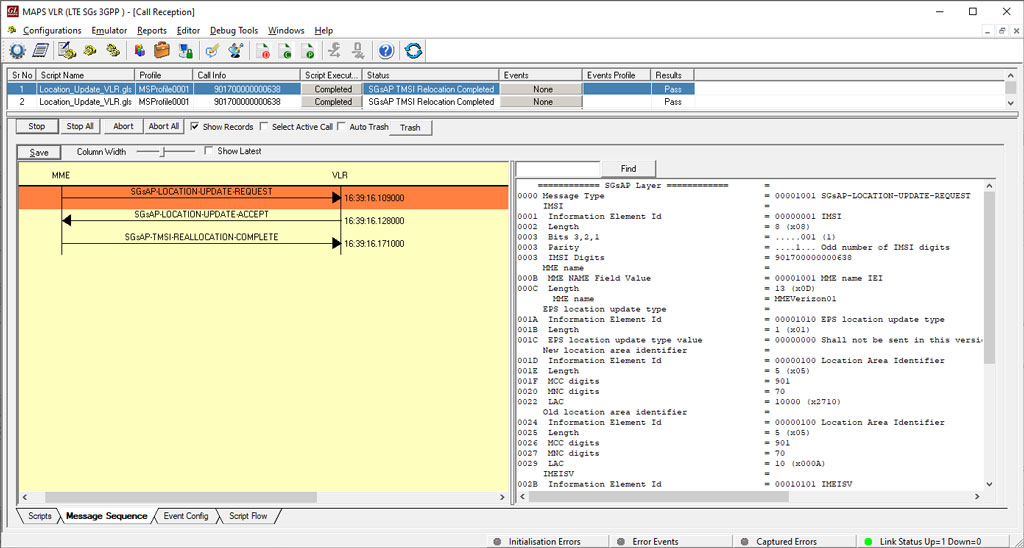MAPS™ LTE SGs Emulator
Emulation of SGs interface between Mobility Management Entity (MME) and Mobile Service Center (MSC) handling Voice and Short Message Service (SMS) to travel over Long Term Evolution (LTE) supporting Circuit Switched Fall Back technology (CSFB).
Brochure Request a Demo / QuoteBackground
CSFB is a technology devised to allow Voice and SMS services to travel over LTE (packet-based all-IP) networks, which cannot normally handle circuit switched services. So, when a LTE device is used to place a voice call or send SMS, the device "falls back" to the 3G or 2G network to complete the call or to deliver the SMS. During such a call scenario, the UE changes its radio access technology from LTE to a 2G/3G technology that supports circuit-switched services. A new interface (called SGs) between the MME and the MSC is required.
The SGs Application Part (SGsAP) protocol messages are used on the SGs interface between the Mobility Management Entity (MME) in the Evolved Packet System (EPS) and the Visitor Location Register (VLR), to allow location management co-ordination and to relay certain messages related to GSM circuit switched services over the EPS system. The basis for the interworking between a VLR and an MME is the existence of a SGs association between the entities per UE. The SGs association is only applicable to UEs with CS Fallback capability activated. CSFB is an interim solution for LTE operators until we have full support for voice over LTE.
Overview
GL’s Message Automation & Protocol Simulation (MAPS™) SGs Emulator is designed to realize the CS fallback function for Voice and SMS delivery via the Circuit Switched (CS) core network using SGs interface between the Mobility Management Entity (MME) in the Evolved Packet System (EPS) and the Visitor Location Register (VLR), as defined in 3GPP TS 29.118 specifications (SGsAP) SGs interface.
The application is available as
- MAPS™ LTE SGs (Item # PKS146) for SGs interface
The MAPS™ SGs Emulator implements the following SGsAP procedures when associations between an MME and a VLR are established:
- Paging for Non-EPS Services
- Location Update for Non-EPS Services
- Non-EPS Alert
- Explicit IMSI Detach from EPS Services
- Explicit IMSI Detach from Non-EPS Services
- Implicit IMSI Detach from Non-EPS services
- VLR Failure
- MME Failure
- MM Information
- Tunnelling of NAS Messages
- Mobile Terminating and Mobile Originating SMS Services
MAPS™ SGs emulator integrated with GL’s multi-protocol and multi-interface lab test solution, covering entire 2G, 3G, and 4G networks simulating CSFB over SGs interface between LTE MME and UTRAN MSC.
By mimicking real-world customer behavior in lab environments, our solutions allow mobile operators and equipment manufacturers to verify their wireless networks before deployment. In other words, one can setup a virtual real-time network simulating all the network elements using “MAPS 2G 3G 4G Wireless Lab Suite”. The test suit supports simulation of 2G, 3G, and 4G entities and connecting interfaces.
Main Features
- Setup a virtual real-time network simulating 4G-LTE network elements using MAPS™ 4G Wireless Lab Suite
- Emulate LTE MME and UTRAN MSC.
- Supports the following SGs interface fallback procedures:
- Paging for non-EPS Services
- Location Update for Non-EPS Services
- Non-EPS Alert
- Explicit IMSI Detach from EPS Services
- Explicit IMSI Detach from Non-EPS Services
- Implicit IMSI Detach from Non-EPS services
- VLR Failure
- MME Failure
- MM Information
- Tunneling of NAS Messages
- Mobile Terminating and Mobile Originating SMS Services
- Insertion of impairments to create invalid messages
- Supports customization of call flow and message templates using Script and Message Editor.
- Ready-to-use scripts for quick testing
- Supports scripted call generation and automated call reception.
- Provides Call Statistics and Events Status.
- Automation, Remote access, and Schedulers to run tests 24/7
Supported Protocols Standards
Supported SGs Interface Procedures
Location Update for Non-EPS Services
The location update for non-EPS services procedure is a general procedure used by UEs which are configured to use CS fallback over SGs. The location update procedure in the SGs interface is always started as a consequence of a direct action from the UEs, combined with attach and tracking area update procedures as per the specification.
MAPS™ SGS Emulator configured as VLR receives and processes the MME-initiated procedures such as Location Updates or Detaches as shown in the screen below.
End-to-End SMS Procedure
The below end-to-end call diagram depicts typical mobile originating SMS service from UE1 and mobile terminating SMS service initiation from the network towards UE2.
During SMS over SGs procedure, LTE UE device sends and retrieves CS based SMS messages between MSC and MME.
Resources
Please Note: The XX in the Item No. refers to the hardware platform, listed at the bottom of the Buyer's Guide, which the software will be running on. Therefore, XX can either be ETA or EEA (Octal/Quad Boards), PTA or PEA (tProbe Units), XUT or XUE (Dual PCIe Express) depending upon the hardware.
| Item No. | Description |
| PKS146 | MAPS™ LTE SGs Emulator |





